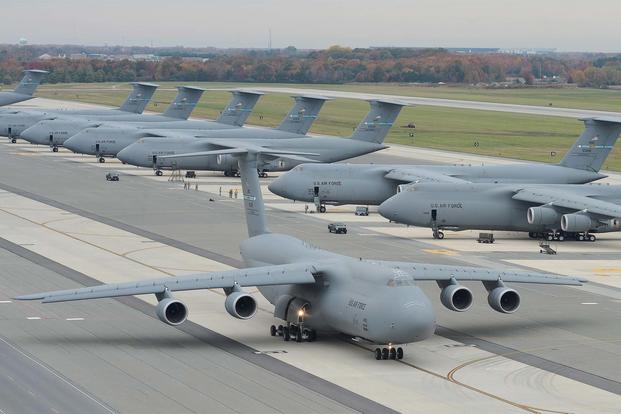Five C-5M Super Galaxies have returned to flying status at Dover Air Force Base, Delaware, while other C-5 bases have begun receiving serviceable parts to immediately overhaul their aircraft’s nose gears, Air Mobility Command officials said Wednesday.
"Serviceable replacement parts to fix the ball-screw drive assemblies" on the nose-gear of the largest cargo airlift plane in the Air Force's inventory have been sent to Dover, as well as Travis Air Force Base, California, Joint Base San Antonio-Lackland, Texas, and Westover Air Reserve Base, Massachusetts, as a preventative maintenance measure, AMC spokesman Col. Chris Karns told Military.com.
Related content:
- Dover C-5s Still Grounded Amid Search for Replacement Parts
- Air Force Halts C-5M Flights from Dover After Nose-Gear Malfunctions
- General Warns of Need to Boost Airlift Capacity
- Air Force Wants More C-5s on the Flightline
Repairs to the C-5s at Dover have now allowed for five of the aircraft to return to flying operations, Karns said.
The service stopped all C-5M operations from the Delaware base July 18 after two aircraft experienced nose-gear malfunctions overseas. Separate incidents involving C-5M aircraft from Dover occurred May 22 and again July 15 at Naval Station Rota, Spain, the command said at the time.
Karns said last month the surprise stand-down affected a total of 18 C-5M aircraft from Dover, including 12 primary aircraft and six in backup status.
"My top priority is safety and readiness of our fleet," said AMC commander Gen. Carlton D. Everhart II. "Our airmen are working deliberately and methodically at Dover and across the command to identify and resolve any issues impacting the C-5 fleet. We have put measures in place to ensure aircrew safety and reduce wear-and-tear on the aircraft," he said in a statement Wednesday.
The commander also issued a policy "restricting the use of kneel operations on all C-5 aircraft to mission essential requirements only," the statement said. "The commander is relying on maintainers and engineers to return aircraft to flying operations as quickly as possible," it said.
"The reference of the 'kneeling operations' is the lowering, or 'kneeling' of the aircraft to make it easier to load cargo, and that can place considerable stress on the aircraft's systems over a period of time," Karns added.
The bases receiving the parts conduct a wide-range of C-5 airlift operations. Westover, specifically, is beginning its transition from the C-5A model to the Super Galaxy. The base announced on Tuesday that one of its last C-5A's tail number 0448, departed for the boneyard at Davis-Monthan Air Force Base, Arizona. Now only two A-models remain in the Air Force's aircraft inventory, the service said.
Last week, Everhart told Military.com that C-5M operations remained in limbo at Dover as maintenance crews and engineers scramble to replace parts -- some of which are no longer manufactured.
The mechanism in question "is a screw-type mechanism that allows [the nose of the aircraft] to basically spin down and spin back up," Everhart said. "What we found out, though, is there's nobody out there manufacturing these anymore."
Crews began inspecting the parts to see how to best re-engineer or recreate them, or to scavenge spare parts from other C-5s, Everhart said.
While the C-5M was first fielded in 2009, the aircraft employ parts from older C-5s dating to the 1980s, Karns said.
There are 56 C-5s in the Air Force's inventory.
Everhart on Wednesday reiterated, "With an aging fleet, it is important to take all potential measures to reduce stress on the aircraft."
-- Oriana Pawlyk can be reached at oriana.pawlyk@military.com.

























